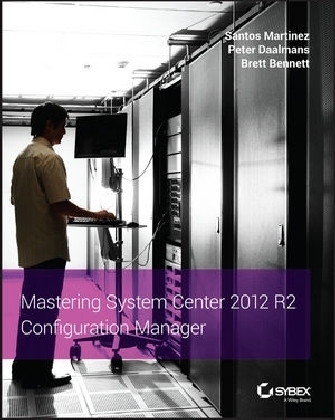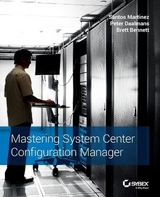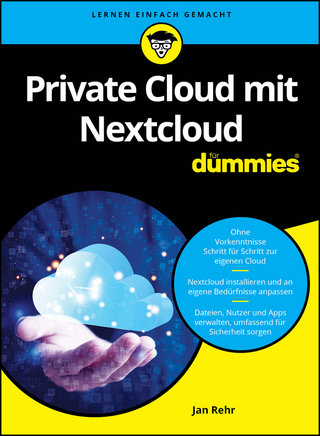
Mastering System Center 2012 R2 Configuration Manager
John Wiley & Sons Inc (Verlag)
978-1-118-82170-1 (ISBN)
- Titel erscheint in neuer Auflage
- Artikel merken
Invaluable coverage on all aspects of System Center 2012 R2 Configuration Manager Completely updated for System Center 2012 R2 Configuration Manager, this comprehensive book provides intermediate and advanced coverage of all aspects of the product, including planning and installation, migrating from previous versions of Configuration Manager, deploying software and operating systems, security, monitoring and troubleshooting, and automating and customizing. * Provides numerous real-world scenarios to show you how to use the tool in various contexts * Explores planning and installation and migrating from SCCM 2007 * Walks you through deploying software and operating systems, security, monitoring, and troubleshooting * Demonstrates automating and customizing SCCM 2012 with scripts This essential book provides you with all the information you need to get savvy with System Center 2012 R2 Configuration Manager.
Santos Martinez, Senior Premier Field Engineer for Microsoft, has been working on ConfigMgr for the past 10 years. He was awarded MVP for ConfigMgr and Databases prior to joining Microsoft. Peter Daalmans is a senior technical consultant at IT-Concern, a Microsoft Gold Certified Partner in the Netherlands. He is an MVP in Enterprise Client Management (ConfigMgr and Windows Intune). Read his blog at ConfigMgrBlog.com. Brett Bennett is a Senior Premier Field Engineer for Microsoft and has been working with SMS/ConfigMgr since SMS Version 1.0.
Introduction xxiii Chapter 1 Overview of Service Management 1 Understanding IT Service Management 1 Exploring the IT Infrastructure Library 2 Select ITIL Functions and Processes 5 Exploring the Microsoft Operations Framework 9 Select MOF Service Management Functions 10 Overview of System Center Configuration Manager 12 Configuration Manager Features 12 Summary 20 Chapter 2 Planning a Configuration Manager Infrastructure 21 Gathering Deployment Intelligence 21 Determining What You Need to Accomplish 22 Describing the Network 23 Describing Your Migration Needs 23 Planning the Configuration Manager Environment 24 System Requirements 24 Extending the Active Directory Schema 37 Hierarchies and Sites 38 Site Boundaries and Boundary Groups 44 Site System Roles 45 Best Practices for Site System Design 47 SQL Considerations 49 Site Communications 50 Site Security Mode 51 Discovery of Your Resources 51 Client Settings and Client Deployment 52 Content Management 52 Role-Based Administration 53 Migration 54 Disaster Recovery 56 Designing Your Configuration Manager Environment 56 Planning the Configuration Manager Hierarchy 58 Planning Configuration Manager Site Systems 59 Planning Configuration Manager Clients 59 Determining How to Deploy Configuration Manager 60 Building a Proof-of-Concept Environment 60 The Bottom Line 64 Chapter 3 Migrating to Configuration Manager 2012 65 Introducing Migration 66 Migration Functionality in Configuration Manager 2012 67 Source Hierarchy 67 Data-Gathering Process 68 Migration Job Types 68 Objects Not Supported for Migration 79 Distribution Point Sharing 79 Planning a Migration 80 Preparing Your Migration 81 Planning Your Migration Strategy 81 Performing the Migration 83 Using the Side-by-Side Migration Strategy 83 Using the Wipe-and-Load Strategy 100 Upgrading the Configuration Manager Console 100 Post-Migration or Installation Considerations 101 Migrating Packages to the New Application Model 103 What Is Package Conversion Manager? 103 The Conversion Process 104 The Conversion Process Steps 109 Package Conversion Manager Best Practices 110 Monitoring Conversion 110 Migrating Branch Offices with the Physical-to-Virtual Migration Toolkit 111 Requirements 112 P2V Migration Scenario 112 The Task Sequence 113 Steps for Using the Configuration Manager 2012 P2V Migration Toolkit 113 The Bottom Line 120 Chapter 4 Installation and Site Role Configuration 121 Understanding Configuration Manager 2012 R2 Site Types 122 Implementing Site Servers 125 Software Requirements 125 Implementing a Central Administration Site 127 Implementing a Primary Site 136 Implementing a Secondary Site 140 Verifying Proper Site Installation 147 Troubleshooting a Configuration Manager 2012 R2 Site Installation 154 Unattended Installation 157 Installing Site System Roles 160 Understanding Configuration Manager 2012 R2 Site System Roles 163 Component Server 165 Distribution Point 165 Management Point 178 Site Database Server 183 Site Server 184 Site System 184 System Health Validator Point 184 State Migration Point 186 Fallback Status Point 189 Out of Band Service Point 191 Reporting Services Point 193 Application Catalog Web Service Point and Application Catalog Website Point 195 Enrollment Point and Enrollment Proxy Point 199 Software Update Point 203 Endpoint Protection Point 209 Asset Intelligence Synchronization Point 210 The Bottom Line 212 Chapter 5 Cloud Integration 213 Windows Azure Integration 214 Management Certificate for Site Server to Distribution Point Communication 215 Creating a Cloud Distribution Point 215 Creating and Exporting the Management Certificate 216 Creating the Service Certificate Template 219 Requesting and Exporting the Service Certificate 220 Uploading the Management Certificate to Windows Azure 222 Creating the Cloud Distribution Point 222 Configure Name Resolution for Cloud-based Distribution Points 225 The Bottom Line 225 Chapter 6 Client Installation 227 Creating Client Settings 227 Supported Operating Systems 232 Discovering Network Objects 234 Active Directory Discovery Methods 235 Configuring Boundaries and Boundary Groups 244 Client Installation Methods 247 Command-Line Properties 247 Manually Installing the Client 252 Client Push 253 Group Policy 257 Software Update 257 Software Distribution 258 Logon Script Installation 258 Imaging 258 Installing Linux/Unix Clients 259 Installing a Mac Client 262 Verifying Client Installation 265 Troubleshooting a Client Installation 266 Ensuring Client Health 266 Automatic Client Remediation 266 Determining Client Health 267 Monitoring Client Status 268 Configuring Alerts 268 Automatic Client Upgrade 270 The Bottom Line 271 Chapter 7 Client Health 273 Understanding the Client Health Mechanism 273 Scheduled Task 274 CCMEval Process 279 Client Health Evaluation: Results 283 Configuring Client Health 284 Monitoring: Client Status 286 Alert: Client Health 287 The Bottom Line 289 Chapter 8 Application Deployment 291 What s New in Application Deployment? 291 Distribution Point Changes 293 Applications: Application References 296 Deployments 296 Dependencies for Application Deployment 299 Management Point 299 Distribution Point 299 Default Client Settings 300 Elements of Application Deployment 308 Applications 308 Deployment Types 308 Deployments 310 The Application Deployment Process 310 Create Application Wizard 311 Creating an Application with PowerShell 314 Options for Application Deployment: the Ribbon 314 Exploring the Sample Application 319 Exploring the Deployment Type 323 Create Deployment Wizard 333 Application Deployment Client Experience 339 Application Deployment Advanced Configurations 343 User Device Affinity 355 Troubleshooting Application Deployment 358 The Bottom Line 361 Chapter 9 Software Updates 363 What s New in Software Updates 364 Prerequisites for Software Updates 366 Elements of Software Updates 367 Software Update Point 367 Software Updates Agent 368 Software Updates Metadata 368 Software Update Files 369 Software Update Objects 369 Software Update Groups 371 Deployment Templates 371 Deployment Packages 372 Deployments 373 Automatic Deployment Rules 374 System Center Updates Publisher 376 The Software Update Process in Configuration Manager 376 Synchronization 376 Compliance 377 Deployment 378 Planning to Use Software Updates in Configuration Manager 380 Determining What Needs to Be Accomplished 380 Role-Based Administration 393 System Center Updates Publisher 394 Testing in an Isolated Lab 395 Configuring Software Updates 396 Configuring the Software Updates Client Agent 396 Installing Windows Server Update Services 30 Server 398 Installing the Windows Server Update Services 30 SP2 Administrative Console 402 Setting Up the Software Update Point 402 Configuring Software Updates Settings and Synchronization 414 Synchronizing Updates with Export and Import 418 Preparing Software Updates for Deployment 419 Finding the Software Updates to Be Deployed 420 Downloading Software Updates 424 Creating a Software Update Group 427 Deploying Software Updates with the Deploy Software Updates Wizard 427 Using System Center Updates Publisher 436 Installing System Center Updates Publisher 436 Configuring System Center Updates Publisher 436 Using System Center Updates Publisher 438 Third-Party Updates in Configuration Manager 443 Monitoring Software Update Deployments 445 In-Console Monitoring 445 Reporting 448 The Bottom Line 450 Chapter 10 Operating System Deployment 451 What s New in Operating System Deployment 451 Planning for OSD with Configuration Manager 2012 452 Deployment Scenarios 452 The Kind of Images to Deploy 452 Operating System Deployment Components 453 User Device Affinity 459 Deployment Process 460 Prepare for Operating System Deployment 460 Build and Capture an Operating System 460 Deploy an Operating System 460 Preparing Configuration Manager 2012 for Operating System Deployment 461 Configuring the Network Access Account 461 Configuring the State Migration Point Role 462 Configuring PXE on Distribution Points 464 Distributing the Boot Image Package 466 Enabling Boot Images for PXE 467 Adding Operating System Source 468 Developing a Task Sequence for Creating a Capture Image 471 Task Sequences Used with PXE Boot 471 Task Sequences Used with Media Boot 475 Capturing an Operating System Image 477 Building and Capturing Automatically 477 Capturing a Reference Computer 480 Deploying an Image 482 Adding a Captured Image 482 Distributing and Deploying the Image 483 Developing a Task Sequence for Deployment 483 Deploying the Task Sequence 487 Deploying the Operating System on Bare Metal 492 Importing Computer Information 492 Creating a Task Sequence for the Bare-Metal OSD 493 Deploying the Bare-Metal Task Sequence 494 Installing Device Drivers into OSD 497 Using User Device Affinity 500 Manually Configure a Primary User for a Device 500 Manually Configure a Primary Device for a User 501 Configure a Site to Automatically Create User Device Affinities 501 Import User Device Affinities 502 Enable Users to Configure Their Primary Device 503 Pre-deploy User Applications 503 Deploying Windows To Go 504 Creating a Prestaged Media for the Task Sequence 504 Creating a Windows To Go Creator Package 506 Update the Task Sequence to Enable BitLocker 507 Running the Windows To Go Package 509 Microsoft Deployment Toolkit 2013 510 Installing Microsoft Deployment Toolkit 2013 510 Integrating the Deployment Toolkit 511 Creating a New Boot Image 512 Creating a Deployment Toolkit Task Sequence 513 Using a Replace Scenario 515 Deploying a Virtual Hard Drive 516 Creating a VHD Task Sequence 516 Creating a Virtual Hard Disk 517 Managing the Virtual Hard Disk 519 Servicing Your Operating System Images and VHDs Offline 520 Support for Legacy Boot Images 522 Maintaining the User State 524 The Bottom Line 525 Chapter 11 Inventory and Software Metering 527 Inventory in Configuration Manager 2012 527 Collecting Hardware Inventory 528 Collecting Software Inventory 533 Using Resource Explorer to View Inventory 535 Scheduling Inventory 536 Configuring Inventory 537 Configuring Software Inventory for a Configuration Manager Site 542 Troubleshooting Inventory 550 Software Metering in Configuration Manager 2012 553 Overview of Software Metering 553 Configuring Software Metering 553 The Bottom Line 562 Chapter 12 Asset Intelligence 563 Requirements for Asset Intelligence 563 Client Agent Prerequisites 564 Maintenance Tasks 564 Windows Ekvent Log Settings 565 Elements of Asset Intelligence 566 Asset Intelligence Catalog 566 Asset Intelligence Validation States 568 Asset Intelligence Synchronization Point 569 The Asset Intelligence Home Page 569 Asset Intelligence Reports 571 Configuring Asset Intelligence 575 Enabling Asset Intelligence 575 Import Software License into Asset Intelligence 578 Importing Software License Information 579 Creating the Microsoft Volume License Statement 579 Creating the General License Statement 580 The Bottom Line 581 Chapter 13 Reporting 583 Installing SQL Server Reporting Services 584 Considerations for Installing SQL Server Reporting Services 585 Installation of the Reporting Services Site System 586 Default Reports 590 Running a Report 593 Viewing Available Reports 593 Running a Report from the Administrative Console 593 Running a Report from Report Manager 594 Working with Reporting Security 596 Permissions Required to Run Reports 596 Managing Reports 601 Working with Subscriptions 609 Creating Reports 611 Basic SQL Commands 612 Report Models 613 Creating a Report Using Report Builder 613 Creating a Report Using Business Intelligence Development Studio 616 Moving Reports 619 Linked Reports 619 Importing and Exporting Reports 620 Importing Reports 620 Exporting Reports 621 The Bottom Line 621 Chapter 14 Compliance Settings 623 Overview of Compliance Settings 623 What s New in Configuration Manager 2012 R2? 624 What Can You Do with Compliance Settings? 625 Configuration Items 625 Configuring Compliance Settings Client Settings 627 Creating Configuration Items 628 Name, Description, and Category 629 Choosing a Detection Method 631 Creating and Validating a Setting 632 Building a Configuration Baseline 639 Creating the Initial Baseline 639 Baseline Rules 640 Assigning the Configuration Baseline to Clients 643 Additional Configuration Baseline Options 644 Client Validation of Compliance Baseline Rules 644 Compliance Settings Reporting 646 Importing Configuration Packs 647 User Data and Profiles 650 Remote Connection Profiles 654 Company Resource Access 656 Certificate Profiles 656 VPN Profiles 660 Wi-Fi Profiles 665 The Bottom Line 668 Chapter 15 System Center Endpoint Protection 669 Differences between FEP and SCEP 669 Additional Benefits of SCEP 670 Deployment 670 Protection 670 Monitoring 672 Security 672 Endpoint Protection Site System Role 672 Endpoint Protection Client Agent 675 Endpoint Protection Policies 679 Antimalware Policy 679 Windows Firewall Policy 685 Assigning Policy 687 Definition Files 687 Alerts 690 Reporting 693 Client Notifications 694 The Bottom Line 699 Chapter 16 Mobile Device Management 701 What s New in Mobile Device Management 701 Mobile Device Management Options 702 Lite Management 705 Depth Management via Client 715 Depth Management via Windows Intune 728 Managing Mobile Devices 742 Device Settings Management 742 Wipe vs Selective Wipe 769 Troubleshooting 771 The Bottom Line 772 Chapter 17 Role-Based Administration 773 Overview of Role-Based Administration 773 Using Security Roles and Security Scopes 774 Managing with Flat Hierarchies 774 Security Roles 774 Security Scopes 778 Creating a Custom Security Scope 779 Assigning Resources to a Security Scope 781 Viewing Security Scope Objects 783 Collections 784 Using Collections 784 Understanding the Default Collections 785 Administrative Users 785 RBA Viewer 793 The Bottom Line 795 Chapter 18 Disaster Recovery 797 Planning for Disaster Recovery 797 What Is Not Included in the Backup 798 Backing Up Configuration Manager 801 Backup Considerations for the Central Administration Site 801 Copying Site Backups to Another Location 802 Archiving the Backup Snapshot to Another Server with AfterBackupbat 802 Windows Application Log Entries Created by the Backup Process 804 Configuring the Backup ConfigMgr Site Server Maintenance Task 805 Restoring Configuration Manager 807 Understanding the Effects of a Site Failure 808 Recovering a Configuration Manager Site 809 Recovering Configuration Manager 811 How to Start a Recovery Process 811 Recovering a Central Administration Site 811 Recovering a Primary Child Site 817 Recovering a Primary Standalone Site 817 Recovering a Secondary Site 818 Recovery Scenarios for Multisite Environments 818 Unattended Recovery of a Site 818 Other Site Maintenance Options 819 The Hierarchy Maintenance Tool 819 Post-Recovery Tasks 821 The Bottom Line 824 Chapter 19 Troubleshooting 827 Creating the Maintenance Plan 827 Using Troubleshooting Tools 832 Log Files 832 Status Messages 837 Troubleshooting Configuration Manager Deployment 845 Troubleshooting Configuration Manager Database Replication 845 Data Types 847 DRS Initialization 848 Additional Tools 852 Server-Based Tools 852 Client-Based Tools 856 The Bottom Line 860 Appendix The Bottom Line 861 Chapter 2: Planning a Configuration Manager Infrastructure 861 Chapter 3: Migrating to Configuration Manager 2012 862 Chapter 4: Installation and Site Role Configuration 865 Chapter 5: Cloud Integration 867 Chapter 6: Client Installation 867 Chapter 7: Client Health 869 Chapter 8: Application Deployment 869 Chapter 9: Software Updates 870 Chapter 10: Operating System Deployment 871 Chapter 11: Inventory and Software Metering 872 Chapter 12: Asset Intelligence 873 Chapter 13: Reporting 874 Chapter 14: Compliance Settings 875 Chapter 15: System Center Endpoint Protection 877 Chapter 16: Mobile Device Management 878 Chapter 17: Role-Based Administration 879 Chapter 18: Disaster Recovery 880 Chapter 19: Troubleshooting 881 Index 883
| Verlagsort | New York |
|---|---|
| Sprache | englisch |
| Maße | 188 x 234 mm |
| Gewicht | 1225 g |
| Einbandart | Paperback |
| Themenwelt | Mathematik / Informatik ► Informatik ► Betriebssysteme / Server |
| Mathematik / Informatik ► Informatik ► Netzwerke | |
| ISBN-10 | 1-118-82170-X / 111882170X |
| ISBN-13 | 978-1-118-82170-1 / 9781118821701 |
| Zustand | Neuware |
| Informationen gemäß Produktsicherheitsverordnung (GPSR) | |
| Haben Sie eine Frage zum Produkt? |
aus dem Bereich



